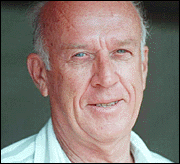Advertisement - Click to support our sponsors.


![]()
View Point
WITHOUT wishing to impugn the integrity or credentials of Dr. Kenneth Sunamoto, I must express my astonishment at the distortions and exaggerations in his April 21 View Point, "Marijuana is not a safe drug." Scare stories on
marijuana are fictionHis casual references to "recent research" and "new scientific evidence" lead me to suspect that his primary sources are government anti-marijuana propaganda manuals, not peer-reviewed scientific journals.
Some of his claims clearly indicate that he has not consulted the prestigious Institute of Medicine report of 1999, which was commissioned and studiously ignored by the nation's drug czar, Gen. Barry McCaffrey. What follows are some specific examples:
Of all the far-fetched claims made by Dr. Sunamoto, however, his comments about inherited genetic changes take the prize. In spite of millions of dollars of taxpayer-funded and government-sponsored research on possible negative effects of marijuana consumption, plus thousands of years of medical use throughout the world, no credible evidence has been found regarding genetic changes.Dr. Sunamoto's questioning of marijuana as a safe medicine is addressed directly by the IOM Report, which states, "Except for the harms associated with smoking, the adverse effects of marijuana use are within the range of effects tolerated for other medications."
Dr. Sunamoto claims "Marijuana is a 'gateway drug.' " The IOM Report: "It does not appear to be a gateway drug; care must be taken not to attribute cause to association."
Dr. Sunamoto says the "resulting physical dependence developed from chronic marijuana use will cause a much more severe abstinence syndrome when marijuana use ceases. Abstinence from marijuana may duplicate the classic cold turkey syndrome of getting off heroin." The IOM Report: "A distinctive marijuana and THC withdrawal syndrome has been identified, but it is mild and subtle compared to the profound physical syndrome of alcohol or heroin withdrawal."
Dr. Sunamoto puts forth that "new scientific studies" have identified that marijuana activates the same dopamine receptor sites as heroin, alcohol and cocaine. This is hardly news. Anything pleasurable stimulates dopamine, including food and sex, so one should not infer that marijuana is the pharmacological equivalent of other drugs like cocaine or heroin, just because it stimulates dopamine activity.
Dr. Sunamoto's reference to marijuana being inhaled by laboratory mice is highly questionable. Except for the infamous, discredited rhesus monkey study, in which the animals were essentially suffocated by marijuana smoke, lab animals are injected with controlled amounts of THC and/or other cannabinoids to study their effects.
I'd like to suggest that Dr. Sunamoto submit his claims to the authors of a 1997 book titled "Marijuana Myths, Marijuana Facts: A Review of the Scientific Evidence." I am sure the authors, Dr. John Morgan and Professor Lynn Zimmer, would be happy to add his claims to their collection of myths.
Furthermore, I suggest that Dr. Sunamoto read the book, which may help guide him through the voluminous scientific literature on marijuana research.
Donald M. Topping is president of the
Drug Policy Forum of Hawaii.